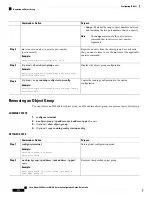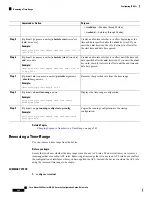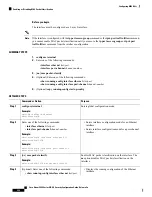
Purpose
Command or Action
•
range
—Matches the range of port numbers between
and including the two port numbers that you specify.
The
range
command is the only operator
command that requires two
port-number
arguments.
Note
Removes an entry from the object group. For each entry
that you want to remove, use the
no
form of the applicable
operator command.
no
{
sequence-number
|
operator port-number
[
port-number
]}
Example:
Step 4
switch(config-port-ogroup)# no eq 80
Displays the object group configuration.
(Optional)
show object-group name
Example:
Step 5
switch(config-port-ogroup)# show object-group
NYC-datacenter-ports
Copies the running configuration to the startup
configuration.
(Optional)
copy running-config startup-config
Example:
Step 6
switch(config-port-ogroup)# copy running-config
startup-config
Removing an Object Group
You can remove an IPv4 address object group, an IPv6 address object group, or a protocol port object group.
SUMMARY STEPS
1.
configure terminal
2.
no object-group
{
ip address
|
ipv6 address
|
ip port
}
name
3.
(Optional)
show object-group
4.
(Optional)
copy running-config startup-config
DETAILED STEPS
Purpose
Command or Action
Enters global configuration mode.
configure terminal
Example:
Step 1
switch# configure terminal
switch(config)#
Removes the specified object group.
no object-group
{
ip address
|
ipv6 address
|
ip port
}
name
Step 2
Example:
switch(config)# no object-group ip address
ipv4-addr-group-A7
Cisco Nexus 9000 Series NX-OS Security Configuration Guide, Release 9.x
278
Configuring IP ACLs
Removing an Object Group






























